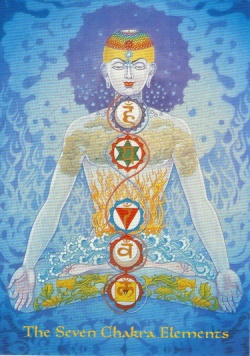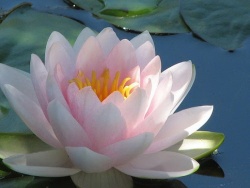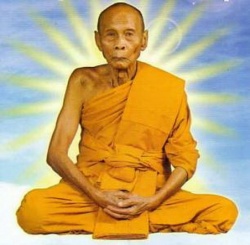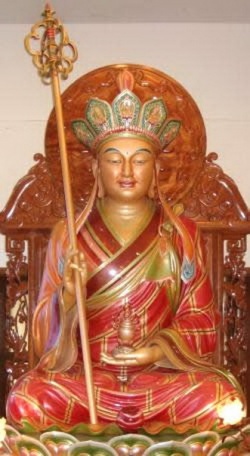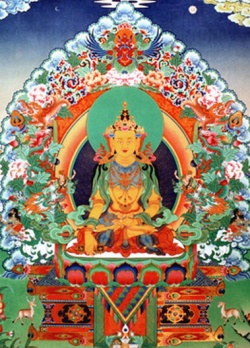Difference between revisions of "Jamgön Kongtrul Lodrö Tayé"
| Line 1: | Line 1: | ||
[[Image:Jamgon Kongtrul Lodro Thaye.jpg|frame|Jamgön Kongtrul the Great]]{{DisplayImages|127|173|1479|1905|1267}} | [[Image:Jamgon Kongtrul Lodro Thaye.jpg|frame|Jamgön Kongtrul the Great]]{{DisplayImages|127|173|1479|1905|1267}} | ||
| − | '''[[Jamgön Kongtrul Lodrö Tayé]]''' (Tib. {{BigTibetan|[[འཇམ་མགོན་ཀོང་སྤྲུལ་བློ་གྲོས་མཐའ་ཡས་]]}}, [[Wyl.]] '' [[‘jam mgon kong sprul blo gros mtha’ yas]]'') (1813-1899) - widely known for synthesizing the [[knowledge]] and [[experience]] of the many [[lineages]] of [[Tibetan Buddhism|Buddhism in Tibet]]. This {{Wiki|synthesis}} is recorded in '[[The Five Great Treasures]]'. He was [[recognized]] by all [[schools of Buddhism]] in [[Tibet]] as one of the greatest [[masters]] of the [[Rimé]] ({{Wiki|ecumenical}}) {{Wiki|movement}}, and is also known for [[writing]] and compiling one hundred volumes of teachings. | + | '''[[Jamgön Kongtrul Lodrö Tayé]]''' (Tib. {{BigTibetan|[[འཇམ་མགོན་ཀོང་སྤྲུལ་བློ་གྲོས་མཐའ་ཡས་]]}}, [[Wyl.]] '' [[‘jam mgon kong sprul blo gros mtha’ yas]]'') (1813-1899) - widely known for synthesizing the [[knowledge]] and [[experience]] of the many [[lineages]] of [[Tibetan Buddhism|Buddhism in Tibet]]. |
| + | |||
| + | This {{Wiki|synthesis}} is recorded in '[[The Five Great Treasures]]'. | ||
| + | |||
| + | He was [[recognized]] by all [[schools of Buddhism]] in [[Tibet]] as one of the greatest [[masters]] of the [[Rimé]] ({{Wiki|ecumenical}}) {{Wiki|movement}}, and is also known for [[writing]] and compiling one hundred volumes of teachings. | ||
| + | |||
| + | |||
=={{Wiki|Biography}}== | =={{Wiki|Biography}}== | ||
| + | |||
| + | |||
The [[sublime]] [[Kongtrul Yönten Gyatso]] (1813-1899) was born in the hidden valley of Rongyap, which lies in front of [[Pema Lhartse]] in Drida Zelmogang in [[East Tibet]], in the [[Water]] {{Wiki|Bird}} year of the fourteenth [[calendrical cycle]]. | The [[sublime]] [[Kongtrul Yönten Gyatso]] (1813-1899) was born in the hidden valley of Rongyap, which lies in front of [[Pema Lhartse]] in Drida Zelmogang in [[East Tibet]], in the [[Water]] {{Wiki|Bird}} year of the fourteenth [[calendrical cycle]]. | ||
| − | His father, was [[Tendzin Yungdrung]] of the {{Wiki| | + | His father, was [[Tendzin Yungdrung]] of the [[royal Khyung clan]] of accomplished practitioners, and his mother was the [[yogini]] [[Tashi Tso]]. |
| + | |||
| + | From his fifth year, he studied the basics of the [[alphabet]] and so on. | ||
| + | |||
| + | Then, from the age of about ten, he began to study on an enormous scale and without {{Wiki|sectarian}} bias, receiving teachings from many [[spiritual]] guides of various [[traditions]], including [[Shechen Öntrul Thutob Namgyal|Gyurme Thutob Namgyal]] of [[Shechen Monastery]], [[Situ Pema Nyinché Wangpo|Tai Situ Pema Nyinché Wangpo]] and [[Jamyang Khyentse Wangpo]]. | ||
| + | |||
| + | He learned all the common {{Wiki|sciences}}, such as [[Sanskrit]] {{Wiki|grammar}}, [[logic]] and {{Wiki|epistemology}} (''[[pramana]]''), [[arts]] and crafts, [[medicine]] and so on, and he studied, reflected and [[meditated]] upon all the uncommon topics of {{Wiki|learning}}, including the [[Madhyamika]], [[Prajnaparamita]], [[Vinaya]] and ''[[Abhidharmakosha]]'' of the [[vehicle of characteristics]], | ||
| + | |||
| + | as well as the [[tantra]]s, commentaries (Skt. ''[[agama]]'') and [[pith instructions]] (Skt. ''[[upadesha]]'') of the [[mantra vehicle]], from both the [[kama]] and [[terma]] and both the [[Nyingma|old]] and [[Sarma|new]] translation schools. | ||
| − | |||
| − | In addition, he dedicated his whole [[life]] to [[teaching]] and spreading the [[Dharma]], by giving [[empowerment]] | + | |
| + | In addition, he dedicated his whole [[life]] to [[teaching]] and spreading the [[Dharma]], by giving [[empowerment's]], instructions, advice and reading [[transmissions]] for both [[sutra]] and [[mantra]], [[kama]] and [[terma]], old and [[new translation]] schools, without any {{Wiki|sectarian}} bias. | ||
Finally, at the age of eighty-seven his [[physical]] [[manifestation]] was absorbed into [[absolute]] [[space]]. | Finally, at the age of eighty-seven his [[physical]] [[manifestation]] was absorbed into [[absolute]] [[space]]. | ||
| + | |||
| + | |||
==His Writings== | ==His Writings== | ||
| + | |||
| + | |||
===[[The Five Great Treasures]]=== | ===[[The Five Great Treasures]]=== | ||
| + | |||
| + | |||
To provide guidance for [[fortunate]] [[disciples]], he composed and edited the ninety volume collection of texts universally renowned as the ‘[[The Five Great Treasures|Five Great Treasures]]’: | To provide guidance for [[fortunate]] [[disciples]], he composed and edited the ninety volume collection of texts universally renowned as the ‘[[The Five Great Treasures|Five Great Treasures]]’: | ||
:'''1.''' The ''[[Treasury of Encyclopedic Knowledge]]'', which brilliantly reveals the [[ground]], [[path]] and [[fruition]] for the whole of [[sutra]] and [[mantrayana|mantra]], from the [[paths]] of the common {{Wiki|sciences}} all the way up to [[Dzogchen]] [[Atiyoga]], which is the culmination of the [[nine vehicles]] in the uncommon approach. | :'''1.''' The ''[[Treasury of Encyclopedic Knowledge]]'', which brilliantly reveals the [[ground]], [[path]] and [[fruition]] for the whole of [[sutra]] and [[mantrayana|mantra]], from the [[paths]] of the common {{Wiki|sciences}} all the way up to [[Dzogchen]] [[Atiyoga]], which is the culmination of the [[nine vehicles]] in the uncommon approach. | ||
| + | |||
| + | |||
::{{TBRC|W5488|{{BigTibetan|[[ཤེས་བྱ་ཀུན་ཁྱབ་མཛོད་]]}}, ''[[shes bya kun khyab mdzod]]''}} | ::{{TBRC|W5488|{{BigTibetan|[[ཤེས་བྱ་ཀུན་ཁྱབ་མཛོད་]]}}, ''[[shes bya kun khyab mdzod]]''}} | ||
| + | |||
| + | |||
:'''2.''' The ''[[Treasury of Precious Instructions]]'', which is a compilation of the most profound maturing [[empowerment]]s and liberating instructions belonging to the [[Eight practice lineages|eight great chariots of the practice lineage]]. | :'''2.''' The ''[[Treasury of Precious Instructions]]'', which is a compilation of the most profound maturing [[empowerment]]s and liberating instructions belonging to the [[Eight practice lineages|eight great chariots of the practice lineage]]. | ||
| + | |||
| + | |||
::{{TBRC|W23605|གདམས་ངག་མཛོད་, ''[[gdams ngag mdzod]]''}} | ::{{TBRC|W23605|གདམས་ངག་མཛོད་, ''[[gdams ngag mdzod]]''}} | ||
| + | |||
| + | |||
:'''3.''' The ''[[Treasury of Kagyü Mantras]]'', which is a compendium of [[mandala]] [[rituals]], maturing [[empowerments]] and liberating instructions, such as [[Yangdak]], [[Vajrakilaya]] and [[Yamantaka]] from the [[Nyingma]] [[kama]], and the [[tantra]] cycles from the [[new translation]] [[lineages]] of [[Marpa]] and [[Ngok]]. | :'''3.''' The ''[[Treasury of Kagyü Mantras]]'', which is a compendium of [[mandala]] [[rituals]], maturing [[empowerments]] and liberating instructions, such as [[Yangdak]], [[Vajrakilaya]] and [[Yamantaka]] from the [[Nyingma]] [[kama]], and the [[tantra]] cycles from the [[new translation]] [[lineages]] of [[Marpa]] and [[Ngok]]. | ||
| + | |||
| + | |||
::{{TBRC|W20876|བཀའ་བརྒྱུད་སྔགས་མཛོད་, ''[[bka' brgyud sngags mdzod]]''}} | ::{{TBRC|W20876|བཀའ་བརྒྱུད་སྔགས་མཛོད་, ''[[bka' brgyud sngags mdzod]]''}} | ||
| + | |||
| + | |||
:'''4.''' The ''[[Treasury of Precious Termas]]'', which distills the quintessence of an ocean of profound [[termas]] within the [[Nyingma]] school. | :'''4.''' The ''[[Treasury of Precious Termas]]'', which distills the quintessence of an ocean of profound [[termas]] within the [[Nyingma]] school. | ||
| + | |||
| + | |||
::{{TBRC|W1KG14|རིན་ཆེན་གཏེར་མཛོད་ཆེན་མོ་, ''[[rin chen gter mdzod chen mo]]''}} | ::{{TBRC|W1KG14|རིན་ཆེན་གཏེར་མཛོད་ཆེན་མོ་, ''[[rin chen gter mdzod chen mo]]''}} | ||
| − | :'''5a)''' The ''Uncommon Treasury'', which contains the unique secret [[treasures]] of his own profound [[terma]] revelations. | + | |
| + | |||
| + | :'''5a)''' The ''Uncommon Treasury'', which contains the unique secret [[treasures]] of his [[own]] profound [[terma]] revelations. | ||
| + | |||
:'''5b)''' The ''[[Treasury of Extensive Teachings]]'', which includes various related works, such as praises and advice, as well as compositions on [[medicine]], [[science]] and so on. | :'''5b)''' The ''[[Treasury of Extensive Teachings]]'', which includes various related works, such as praises and advice, as well as compositions on [[medicine]], [[science]] and so on. | ||
| + | |||
| + | |||
::{{TBRC|W23723|རྒྱ་ཆེན་བཀའ་མཛོད་, ''[[rgya chen bka' mdzod]]''}}<noinclude> | ::{{TBRC|W23723|རྒྱ་ཆེན་བཀའ་མཛོད་, ''[[rgya chen bka' mdzod]]''}}<noinclude> | ||
===Other Writings=== | ===Other Writings=== | ||
| − | *''[[The Torch of Certainty]]'' (Tib. {{BigTibetan|[[ངེས་དོན་སྒྲོན་མེ་]]}}, [[Wyl.]] ''[[nges don sgron me]]''), a commentary on the brief [[root text]] ''[[lhan cig skyes sbyor khrid]]'' by the [[Ninth Karmapa]], [[Wangchuk Dorje]], which contains instructions on the [[Kagyü]] [[preliminary practices]] and [[Mahamudra]] [[meditation]]. Only the first part has been translated and published under the title ''[[The Torch of Certainty]]'' (Boston: [[Shambhala Publications]], 1977, 2000). | + | |
| + | |||
| + | *''[[The Torch of Certainty]]'' (Tib. {{BigTibetan|[[ངེས་དོན་སྒྲོན་མེ་]]}}, [[Wyl.]] ''[[nges don sgron me]]''), a commentary on the brief [[root text]] ''[[lhan cig skyes sbyor khrid]]'' by the [[Ninth Karmapa]], [[Wangchuk Dorje]], which contains instructions on the [[Kagyü]] [[preliminary practices]] and [[Mahamudra]] [[meditation]]. | ||
| + | |||
| + | Only the first part has been translated and published under the title ''[[The Torch of Certainty]]'' (Boston: [[Shambhala Publications]], 1977, 2000). | ||
| + | |||
| + | |||
*''[[Changchub Shunglam]]'', a commentary on the ''[[Seven Points of Mind Training]]''. | *''[[Changchub Shunglam]]'', a commentary on the ''[[Seven Points of Mind Training]]''. | ||
| + | |||
*''[[Lives of the Hundred Tertöns]]'' | *''[[Lives of the Hundred Tertöns]]'' | ||
| + | |||
==His Students== | ==His Students== | ||
| − | His students included [[lineage]] holders from the [[Kagyü]] school, headed by the [[Thekchok Dorje|Fourteenth]] and [[Fifteenth Karmapa]]s and the Tenth and [[Palpung Situ Pema Wangchok Gyalpo|Eleventh Tai Situpas]], as well as [[masters]] of the [[Sakya]] and [[Ngor tradition]]s including [[Jamyang Loter Wangpo]] and [[Chöjé Kunga Jamyang]], holders of the [[Early Translation]] teachings including [[Mipham Jamyang Namgyal]] and [[Tertön Sogyal Lerab Lingpa]], and [[masters]] from the [[Gelugpa|Riwo Gendenpa]] [[tradition]], including [[Gyümé]] [[Khenpo]] Yeshe Gongphel and [[Drakyab Dongtrul Khechok Ngawang Damchö Gyatso]]. In short, his [[disciples]] were incredibly vast in number and came from all over [[Tibet]], from the provinces of [[Ü]] and [[Tsang]] in [[Central Tibet]] and also from the upper, middle and lower regions of [[East Tibet]]. | + | |
| + | |||
| + | His students included [[lineage]] holders from the [[Kagyü]] school, headed by the [[Thekchok Dorje|Fourteenth]] and [[Fifteenth Karmapa]]s and the Tenth and [[Palpung Situ Pema Wangchok Gyalpo|Eleventh Tai Situpas]], as well as [[masters]] of the [[Sakya]] and [[Ngor tradition]]s including [[Jamyang Loter Wangpo]] and [[Chöjé Kunga Jamyang]], holders of the [[Early Translation]] teachings including [[Mipham Jamyang Namgyal]] and [[Tertön Sogyal Lerab Lingpa]], and [[masters]] from the [[Gelugpa|Riwo Gendenpa]] [[tradition]], including [[Gyümé]] [[Khenpo]] Yeshe Gongphel and [[Drakyab Dongtrul Khechok Ngawang Damchö Gyatso]]. | ||
| + | |||
| + | In short, his [[disciples]] were incredibly vast in number and came from all over [[Tibet]], from the provinces of [[Ü]] and [[Tsang]] in [[Central Tibet]] and also from the upper, middle and lower regions of [[East Tibet]]. | ||
| + | |||
==[[Incarnations]]== | ==[[Incarnations]]== | ||
| + | |||
| + | |||
[[Jamgön Kongtrul]] had five immediate [[incarnations]]. | [[Jamgön Kongtrul]] had five immediate [[incarnations]]. | ||
| + | |||
| + | |||
Two [[emanations]] were discovered at [[Palpung]]: | Two [[emanations]] were discovered at [[Palpung]]: | ||
| + | |||
*[[Karsé Kongtrul]], [[Palden]] [[Khyentsé]] Özer, (1904-1952) who was the son of the [[Khakhyap Dorje|Fifteenth Karmapa]], and | *[[Karsé Kongtrul]], [[Palden]] [[Khyentsé]] Özer, (1904-1952) who was the son of the [[Khakhyap Dorje|Fifteenth Karmapa]], and | ||
| + | |||
*[[Dzigar Kongtrul Lodrö Rabpel]] (1901?-c.1958). | *[[Dzigar Kongtrul Lodrö Rabpel]] (1901?-c.1958). | ||
| + | |||
| + | |||
The three others were: | The three others were: | ||
| + | |||
*[[Shechen Kongtrul Pema Drimé Lekpé Lodrö]] (1901-c.1960), | *[[Shechen Kongtrul Pema Drimé Lekpé Lodrö]] (1901-c.1960), | ||
| + | |||
*[[Dzogchen Kongtrul Gyurme Könchok Gyaltsen]] and | *[[Dzogchen Kongtrul Gyurme Könchok Gyaltsen]] and | ||
| + | |||
*[[Kalu Rinpoche]] (1905-1989). | *[[Kalu Rinpoche]] (1905-1989). | ||
| + | |||
==Further Reading== | ==Further Reading== | ||
| − | *[[Dudjom Rinpoche]], ''[[The Nyingma School of Tibetan Buddhism, Its Fundamentals and History]]'', trans. and ed. [[Gyurme Dorje]] (Boston: Wisdom, 1991), vol.1 pp.859- | + | |
| + | *[[Dudjom Rinpoche]], ''[[The Nyingma School of Tibetan Buddhism, Its Fundamentals and History]]'', trans. and ed. [[Gyurme Dorje]] (Boston: Wisdom, 1991), vol.1 pp.859- | ||
| + | |||
*[[E. Gene Smith]], '[[‘Jam mgon Kong sprul and the Nonsectarian Movement]]' in ''Among [[Tibetan Texts]]'', [[Wisdom Publications]], 2001 | *[[E. Gene Smith]], '[[‘Jam mgon Kong sprul and the Nonsectarian Movement]]' in ''Among [[Tibetan Texts]]'', [[Wisdom Publications]], 2001 | ||
| + | |||
*[[Jamgön Kongtrul]], ''[[The Autobiography of Jamgön Kongtrul: A Gem of Many Colors]]'', translated by [[Richard Barron]], [[Snow Lion Publication]], 2003 | *[[Jamgön Kongtrul]], ''[[The Autobiography of Jamgön Kongtrul: A Gem of Many Colors]]'', translated by [[Richard Barron]], [[Snow Lion Publication]], 2003 | ||
| + | |||
*[[Ngawang Zangpo]], ''[[Jamgön Kongtrul's Retreat Manual]]'', [[Snow Lion Publication]]n, 1994 | *[[Ngawang Zangpo]], ''[[Jamgön Kongtrul's Retreat Manual]]'', [[Snow Lion Publication]]n, 1994 | ||
| + | |||
*[[Nyoshul Khenpo]], ''[[A Marvelous Garland of Rare Gems: Biographies of Masters of Awareness in the Dzogchen Lineage]]'' (Junction City: [[Padma Publications]], 2005), pages 410-415. | *[[Nyoshul Khenpo]], ''[[A Marvelous Garland of Rare Gems: Biographies of Masters of Awareness in the Dzogchen Lineage]]'' (Junction City: [[Padma Publications]], 2005), pages 410-415. | ||
| + | |||
*[[Ringu Tulku]], ''The [[Ri-me]] [[Philosophy]] of [[Jamgön Kongtrul]] the Great'' (Boston & {{Wiki|London}}: [[Shambhala Publications]], 2006), '2. The {{Wiki|Biography}} of [[Kongtrul Yönten Gyatso]]'. | *[[Ringu Tulku]], ''The [[Ri-me]] [[Philosophy]] of [[Jamgön Kongtrul]] the Great'' (Boston & {{Wiki|London}}: [[Shambhala Publications]], 2006), '2. The {{Wiki|Biography}} of [[Kongtrul Yönten Gyatso]]'. | ||
| + | |||
==See Also== | ==See Also== | ||
| + | |||
*[[Kongtrul Incarnation Line]] | *[[Kongtrul Incarnation Line]] | ||
| + | |||
*[[Prayer to Jamgön Kongtrul Lodrö Tayé]] | *[[Prayer to Jamgön Kongtrul Lodrö Tayé]] | ||
| + | |||
*[[Tsadra Rinchen Drak]] | *[[Tsadra Rinchen Drak]] | ||
| + | |||
==External Links== | ==External Links== | ||
| + | |||
*{{LH|tibetan-masters/jamgon-kongtrul/biography|''Biography of Jamgön Kongtrul Lodrö Thayé''}} by [[Alak Zenkar Rinpoche]] | *{{LH|tibetan-masters/jamgon-kongtrul/biography|''Biography of Jamgön Kongtrul Lodrö Thayé''}} by [[Alak Zenkar Rinpoche]] | ||
*{{LH|tibetan-masters/jamgon-kongtrul|Jamgön Kongtrul Lodrö Thaye series on Lotsawa House}} | *{{LH|tibetan-masters/jamgon-kongtrul|Jamgön Kongtrul Lodrö Thaye series on Lotsawa House}} | ||
Latest revision as of 10:01, 18 February 2015
Jamgön Kongtrul Lodrö Tayé (Tib. འཇམ་མགོན་ཀོང་སྤྲུལ་བློ་གྲོས་མཐའ་ཡས་, Wyl. ‘jam mgon kong sprul blo gros mtha’ yas) (1813-1899) - widely known for synthesizing the knowledge and experience of the many lineages of Buddhism in Tibet.
This synthesis is recorded in 'The Five Great Treasures'.
He was recognized by all schools of Buddhism in Tibet as one of the greatest masters of the Rimé (ecumenical) movement, and is also known for writing and compiling one hundred volumes of teachings.
Biography
The sublime Kongtrul Yönten Gyatso (1813-1899) was born in the hidden valley of Rongyap, which lies in front of Pema Lhartse in Drida Zelmogang in East Tibet, in the Water Bird year of the fourteenth calendrical cycle.
His father, was Tendzin Yungdrung of the royal Khyung clan of accomplished practitioners, and his mother was the yogini Tashi Tso.
From his fifth year, he studied the basics of the alphabet and so on.
Then, from the age of about ten, he began to study on an enormous scale and without sectarian bias, receiving teachings from many spiritual guides of various traditions, including Gyurme Thutob Namgyal of Shechen Monastery, Tai Situ Pema Nyinché Wangpo and Jamyang Khyentse Wangpo.
He learned all the common sciences, such as Sanskrit grammar, logic and epistemology (pramana), arts and crafts, medicine and so on, and he studied, reflected and meditated upon all the uncommon topics of learning, including the Madhyamika, Prajnaparamita, Vinaya and Abhidharmakosha of the vehicle of characteristics,
as well as the tantras, commentaries (Skt. agama) and pith instructions (Skt. upadesha) of the mantra vehicle, from both the kama and terma and both the old and new translation schools.
In addition, he dedicated his whole life to teaching and spreading the Dharma, by giving empowerment's, instructions, advice and reading transmissions for both sutra and mantra, kama and terma, old and new translation schools, without any sectarian bias.
Finally, at the age of eighty-seven his physical manifestation was absorbed into absolute space.
His Writings
The Five Great Treasures
To provide guidance for fortunate disciples, he composed and edited the ninety volume collection of texts universally renowned as the ‘Five Great Treasures’:
- 1. The Treasury of Encyclopedic Knowledge, which brilliantly reveals the ground, path and fruition for the whole of sutra and mantra, from the paths of the common sciences all the way up to Dzogchen Atiyoga, which is the culmination of the nine vehicles in the uncommon approach.
- 2. The Treasury of Precious Instructions, which is a compilation of the most profound maturing empowerments and liberating instructions belonging to the eight great chariots of the practice lineage.
- 3. The Treasury of Kagyü Mantras, which is a compendium of mandala rituals, maturing empowerments and liberating instructions, such as Yangdak, Vajrakilaya and Yamantaka from the Nyingma kama, and the tantra cycles from the new translation lineages of Marpa and Ngok.
- 4. The Treasury of Precious Termas, which distills the quintessence of an ocean of profound termas within the Nyingma school.
- 5a) The Uncommon Treasury, which contains the unique secret treasures of his own profound terma revelations.
- 5b) The Treasury of Extensive Teachings, which includes various related works, such as praises and advice, as well as compositions on medicine, science and so on.
Other Writings
- The Torch of Certainty (Tib. ངེས་དོན་སྒྲོན་མེ་, Wyl. nges don sgron me), a commentary on the brief root text lhan cig skyes sbyor khrid by the Ninth Karmapa, Wangchuk Dorje, which contains instructions on the Kagyü preliminary practices and Mahamudra meditation.
Only the first part has been translated and published under the title The Torch of Certainty (Boston: Shambhala Publications, 1977, 2000).
- Changchub Shunglam, a commentary on the Seven Points of Mind Training.
His Students
His students included lineage holders from the Kagyü school, headed by the Fourteenth and Fifteenth Karmapas and the Tenth and Eleventh Tai Situpas, as well as masters of the Sakya and Ngor traditions including Jamyang Loter Wangpo and Chöjé Kunga Jamyang, holders of the Early Translation teachings including Mipham Jamyang Namgyal and Tertön Sogyal Lerab Lingpa, and masters from the Riwo Gendenpa tradition, including Gyümé Khenpo Yeshe Gongphel and Drakyab Dongtrul Khechok Ngawang Damchö Gyatso.
In short, his disciples were incredibly vast in number and came from all over Tibet, from the provinces of Ü and Tsang in Central Tibet and also from the upper, middle and lower regions of East Tibet.
Incarnations
Jamgön Kongtrul had five immediate incarnations.
Two emanations were discovered at Palpung:
- Karsé Kongtrul, Palden Khyentsé Özer, (1904-1952) who was the son of the Fifteenth Karmapa, and
- Dzigar Kongtrul Lodrö Rabpel (1901?-c.1958).
The three others were:
- Shechen Kongtrul Pema Drimé Lekpé Lodrö (1901-c.1960),
- Kalu Rinpoche (1905-1989).
Further Reading
- Dudjom Rinpoche, The Nyingma School of Tibetan Buddhism, Its Fundamentals and History, trans. and ed. Gyurme Dorje (Boston: Wisdom, 1991), vol.1 pp.859-
- E. Gene Smith, '‘Jam mgon Kong sprul and the Nonsectarian Movement' in Among Tibetan Texts, Wisdom Publications, 2001
- Jamgön Kongtrul, The Autobiography of Jamgön Kongtrul: A Gem of Many Colors, translated by Richard Barron, Snow Lion Publication, 2003
- Nyoshul Khenpo, A Marvelous Garland of Rare Gems: Biographies of Masters of Awareness in the Dzogchen Lineage (Junction City: Padma Publications, 2005), pages 410-415.
- Ringu Tulku, The Ri-me Philosophy of Jamgön Kongtrul the Great (Boston & London: Shambhala Publications, 2006), '2. The Biography of Kongtrul Yönten Gyatso'.
See Also
External Links
- Biography of Jamgön Kongtrul Lodrö Thayé by Alak Zenkar Rinpoche
- Jamgön Kongtrul Lodrö Thaye series on Lotsawa House
 TBRC Profile
TBRC Profile

